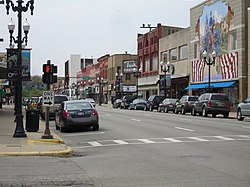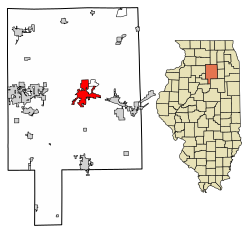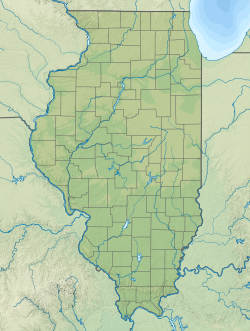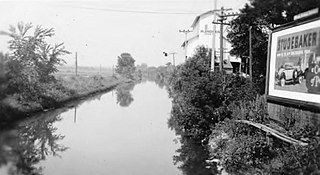
The Illinois and Michigan Canal connected the Great Lakes to the Mississippi River and the Gulf of Mexico. In Illinois, it ran 96 miles (154 km) from the Chicago River in Bridgeport, Chicago to the Illinois River at LaSalle-Peru. The canal crossed the Chicago Portage, and helped establish Chicago as the transportation hub of the United States, before the railroad era. It was opened in 1848. Its function was partially replaced by the wider and deeper Chicago Sanitary and Ship Canal in 1900, and it ceased transportation operations with the completion of the Illinois Waterway in 1933.

The Illinois River is a principal tributary of the Mississippi River at approximately 273 miles (439 km) in length. Located in the U.S. state of Illinois, the river has a drainage basin of 28,756.6 square miles (74,479 km2). The Illinois River begins with the confluence of the Des Plaines and Kankakee rivers in the Chicago metropolitan area, and it generally flows to the southwest across Illinois, until it empties into the Mississippi near Grafton, Illinois. Its drainage basin extends into southeastern Wisconsin, northwestern Indiana, and a very small area of southwestern Michigan in addition to central Illinois. Along its shores are several river ports, including Peoria, Illinois. Historic and recreation areas on the river include Starved Rock, and the internationally important wetlands of the Emiquon Complex and Dixon Waterfowl Refuge.

LaSalle County is located within the Fox Valley and Illinois River Valley regions of the U.S. state of Illinois. As of the 2020 Census, it had a population of 109,658. Its county seat and largest city is Ottawa. LaSalle County is part of the Ottawa, IL Micropolitan Statistical Area of Northern Illinois.

Lyons is a village in Cook County, Illinois, United States. Per the 2020 census, the population was 10,817. The Chicago Portage National Historic Site is located in Lyons.
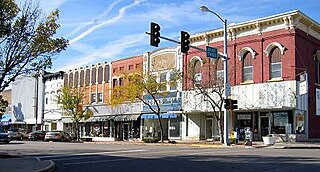
LaSalle or La Salle is a city in LaSalle County, Illinois, United States, located at the intersection of Interstates 39 and 80. It is part of the Ottawa, IL Micropolitan Statistical Area. Originally platted in 1837 over one square mile, the city's boundaries have grown to 12 sq mi (31 km2). City boundaries extend from the Illinois River and Illinois and Michigan Canal to a mile north of Interstate 80 and from the city of Peru on the west to the village of North Utica on the east. Starved Rock State Park is located approximately 5 mi (8 km) to the east. The population was 9,582 as of the 2020 census, down from 9,609 at the 2010 census. LaSalle and its twin city, Peru, make up the core of the Illinois Valley. Due to their combined dominance of the zinc processing industry in the early 1900s, they were collectively nicknamed "Zinc City."

Marseilles is a city in LaSalle County, Illinois, United States. An Illinois River town, the population was 4,845 at the 2020 census, down from 5,094 at the 2010 census. It is part of the Ottawa, IL Micropolitan Statistical Area.

Naplate is a village in LaSalle County, Illinois, United States. The population was 412 at the 2020 census. It is part of the Ottawa Micropolitan Statistical Area.

Peru is a city in LaSalle and Bureau counties, Illinois, United States. The population was 9,896 at the 2020 census, down from 10,295 at the 2010 census. It is part of the Ottawa, IL Micropolitan Statistical Area. Peru and its twin city, LaSalle, make up the core of Illinois Valley.

Streator is a city in LaSalle and Livingston counties in the U.S. state of Illinois. The city is situated on the Vermilion River approximately 81 miles (130 km) southwest of Chicago in the prairie and farm land of north-central Illinois. As of the 2020 census, the population of Streator was 12,500.
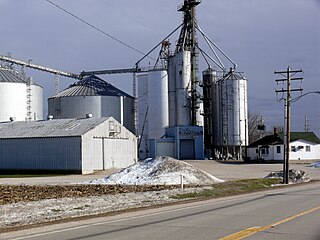
Troy Grove is a village in LaSalle County, Illinois, United States. The population was 225 at the 2020 census, down from 250 at the 2010 census. It is part of the Ottawa, IL Micropolitan Statistical Area.

Fostoria is a city located at the convergence of Hancock, Seneca, and Wood counties in the northwestern part of the U.S. state of Ohio. The population was 13,046 at the 2020 Census, slightly down from 13,441 at the 2010 Census. It is approximately 40 miles (64 km) south of Toledo and 90 miles (140 km) north of Columbus. The community grew substantially during the end of the 19th century, coinciding with the northwest Ohio gas boom. Typical of Rust Belt cities, Fostoria peaked in size in 1970.

William Dickson Boyce was an American newspaper man, entrepreneur, magazine publisher, and explorer. He was the founder of the Boy Scouts of America (BSA) and the short-lived Lone Scouts of America (LSA). Born in Allegheny County, Pennsylvania, he acquired a love for the outdoors early in his life. After working as a schoolteacher and a coal miner, Boyce attended Wooster Academy in Ohio before moving to the Midwest and Canada. An astute businessman, Boyce successfully established several newspapers, such as The Commercial in Winnipeg, Manitoba, and the Lisbon Clipper in Lisbon, North Dakota. With his first wife, Mary Jane Beacom, he moved to Chicago to pursue his entrepreneurial ambitions. There he established the Mutual Newspaper Publishing Company and the weekly Saturday Blade, which catered to a rural audience and was distributed by thousands of newspaper boys. With his novel employment of newsboys to boost newspaper sales, Boyce's namesake publishing company maintained a circulation of 500,000 copies per week by 1894. Boyce strongly supported worker rights, as demonstrated by his businesses' support of labor unions and his concern for his newsboys' well-being.

The Radium Girls were female factory workers who contracted radiation poisoning from painting radium dials – watch dials and hands with self-luminous paint. The incidents occurred at three factories in the United States: one in Orange, New Jersey, beginning around 1917; one in Ottawa, Illinois, beginning in the early 1920s; and one in Waterbury, Connecticut, also in the 1920s.

Radioluminescence is the phenomenon by which light is produced in a material by bombardment with ionizing radiation such as alpha particles, beta particles, or gamma rays. Radioluminescence is used as a low level light source for night illumination of instruments or signage. Radioluminescent paint is occasionally used for clock hands and instrument dials, enabling them to be read in the dark. Radioluminescence is also sometimes seen around high-power radiation sources, such as nuclear reactors and radioisotopes.
The Chicago Portage was an ancient portage that connected the Great Lakes waterway system with the Mississippi River system. Connecting these two great water trails meant comparatively easy access from the mouth of the St. Lawrence River on the Atlantic Ocean to the Rocky Mountains, and the Gulf of Mexico. The approximately six-mile link had been used by Native Americans for thousands of years during the Pre-Columbian era for travel and trade.
The United States Radium Corporation was a company, most notorious for its operations between the years 1917 to 1926 in Orange, New Jersey, in the United States that led to stronger worker protection laws. After initial success in developing a glow-in-the-dark radioactive paint, the company was subject to several lawsuits in the late 1920s in the wake of severe illnesses and deaths of workers who had ingested radioactive material. The workers had been told that the paint was harmless. During World War I and World War II, the company produced luminous watches and gauges for the United States Army for use by soldiers.
The Radium Dial Company was one of a few now defunct United States companies, along with the United States Radium Corporation, involved in the painting of clocks, watches and other instrument dials using radioluminescent paint containing radium. The resulting dials are now collectively known as radium dials. The luminous paint used on the dials contained a mixture of zinc sulfide activated with silver, and powdered radium, a product that the Radium Dial Company named Luma. However, unlike the US Radium Corporation, Radium Dial Company was specifically set up to only paint dials, and no other radium processing took place at the premises.

Washington Park Historic District, also known as Washington Square is a historic district in and around Washington Park in the city of Ottawa, Illinois, United States. Washington Park was the site of the first Lincoln-Douglas debates of 1858 and is surrounded by several historic structures. The park was platted in 1831 and the historic district was added to the United States National Register of Historic Places in 1973.
The W. D. Boyce Council of the Boy Scouts of America serves youth in central Illinois, from Lincoln to Ottawa, and Peoria to Bloomington.

William Reddick was an Irish-American businessman, farmer, lawman, politician, landowner and philanthropist. Immigrating to the United States with his family at the age of four, Reddick became one of the most prominent citizens of early Ottawa, Illinois. Having a lifelong interest in education, Reddick supported the foundation of the University of Illinois and assisted in the establishment of a public school system for the youth of Ottawa.
